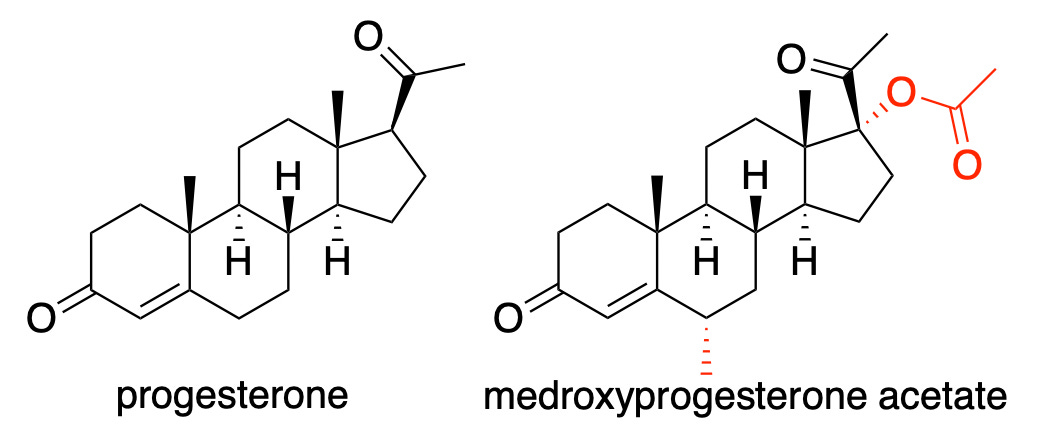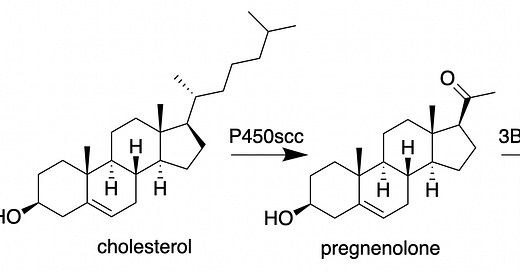A recent Astral Codex Ten post explored the link between progesterone, its metabolite allopregnanolone, and depression. One of the questions it raised was “why can’t we just give people progesterone and let them metabolize it into allopregnanolone?”
Funnily enough, today in the lab I was doing an experiment measuring progesterone production (as part of my work on making a human ovary in vitro).
I’m not going to scoop Scott here, but I think it would be good to explain some background info on progesterone so readers have a better sense of what’s going on.
This post is also in honor of International Women’s Day. May your hormones be forever in your favor.
1. How is progesterone made?
Progesterone is a steroid hormone, and like other steroid hormones it is produced by the oxidation of cholesterol. Biochemically, this takes only two enzymes: cholesterol side chain cleavage enzyme (P450scc), and 3β hydroxysteroid dehydrogenase (3BHSD). P450scc, the rate-limiting enzyme, is expressed in steroidogenic tissues such as the ovary, testes, adrenal glands, and placenta.
Progesterone is an important precursor for the production of other steroid hormones, including the corticosteroids, androgens, and estrogens. As mentioned by the recent Astral Codex Ten post, progesterone can also be reduced to allopregnanolone by the enzymes 5α reductase and 3α hydroxysteroid dehydrogenase. These enzymes are present in multiple tissues, so unless they’re inhibited, progesterone is going to get converted to allopregnanolone.
Interesting thought: do 5α-reductase inhibitors cause depression?
Progesterone is produced as an intermediate in most steroidogenic tissues, but the highest amounts are released by the corpus luteum in the ovary. This tissue differentiates from the ovarian granulosa cells in response to luteinizing hormone (LH), and is maintained during pregnancy by human chorionic gonadotropin, which activates the same receptor as LH. During pregnancy, the placenta also produces high levels of progesterone, which by about 10–12 weeks of gestation is the major source in the pregnant woman.
2. What does progesterone do?
There are two biological targets of progesterone: the nuclear progesterone receptor (PR) and the membrane progesterone receptor (mPR, which is actually a family of closely related receptors).
The PR is similar to other nuclear receptors for steroid hormones, in that it is a transcription factor. When progesterone binds, the PR directly activates transcription of target genes. The PR is expressed in a wide variety of cell types, but depending on the cell type, different isoforms of the PR can be expressed, having different target genes. In general, the PR mediates most of the effects of progesterone in the female reproductive system.
The mPR is less well-understood, but seems to be important for the effects of progesterone on the nervous system and pituitary gland. It sort of resembles a G-protein coupled receptor, but to my knowledge no partner G-proteins have been identified.
These signaling pathways have a long list of downstream effects. I’m most familiar with the ones in the female reproductive system, which are:
Induces decidualization of the endometrium (important for pregnancy)
Promotes breast development (but inhibits lactation)
Decreases expression of the estrogen receptor (so estrogen doesn’t have as much of an effect)
Suppresses release of pituitary gonadotropins (FSH and LH). This shuts off the menstrual cycle during pregnancy.
Overall, progesterone is basically the hormone that tells the body that you’re pregnant.
One additional effect worth noting is that progesterone is a mineralocorticoid receptor antagonist, which means it acts as a diuretic (increasing urine volume). Long-term elevated progesterone, such as during pregnancy, causes an increase in aldosterone to compensate for this effect.
3. So, what happens if you give women progesterone?
Basically this is Provera birth control (better known as Depo-Provera in the long-acting injectable formulation). This has well-known effects and side effects.

This compound, medroxyprogesterone acetate, isn’t exactly progesterone and won’t get converted to allopregnanolone. But the effects of activating the progesterone receptor will be the same whether you give someone progesterone or medroxyprogesterone acetate.
4. But what about the men?
Progesterone is present in men as an intermediate in the biosynthesis of other hormones. In general, the levels in men are similar to women in the early phase of the menstrual cycle (before the corpus luteum has developed). If men are dosed with extra progesterone, it obviously won’t have the uterine effects, but I expect it would have all of the other effects (although I couldn’t find any studies on this). Notably, medroxyprogesterone acetate is used as a form of “chemical castration” since it inhibits androgen production. Unlike actual castration, the effects are reversible if treatment is stopped (although this takes a few months).
(Note that medroxyprogesterone acetate is not exactly the same as progesterone, so the effects of progesterone may differ. In particular, progesterone will be more rapidly converted to other steroid hormones.)
5. A rather wild study (with cocaine!)
While doing research for this post I found a study which gave progesterone to women and men, then measured how they felt when they smoked cocaine.
I’m not so interested in the cocaine part, but the study does have data on progesterone dosing. Five doses of 150 mg progesterone over three days in men were sufficient to produce serum levels of ~7 ng/mL, similar to levels in women during the luteal phase of the menstrual cycle. (Levels in pregnant women are typically 10 times higher. )
In general, oral absorption of steroids is low because much will be degraded by the liver before reaching the bloodstream, but this study shows that progesterone is feasible to dose orally. The duration of the study (3 days) was probably too short to evaluate side effects.
6. Conclusions
Progesterone is produced at moderate levels as an intermediate for other steroids, and at much higher levels in the second half of the menstrual cycle and pregnancy.
Progesterone acts on the PR and mPR, the overall effects in women being to say, “I’m pregnant.”
Progesterone can be delivered orally. For women, taking it will act as a contraceptive (assuming a sufficient dose). For men, it will probably have antiandrogenic effects, although I couldn’t find studies directly showing this.
So, if you’re a woman and want contraception, taking progesterone will be fine. Otherwise, the side effects may be a problem.




A few thoughts:
1. Progesterone has been given to men, in the form of Norethisterone - suicidal ideation / depression is the reason we don’t have a male hormonal contraceptive.
2. The progesterone only pill has a higher risk of depression than the combined pill in women. This is particularly the case for older more ‘androgenic’ forms of synthetic progesterone
https://jamanetwork.com/journals/jamapsychiatry/fullarticle/2552796
3. 5α-reductase inhibitors are actually an effective treatment for PMDD by blocking allopregnanolone production https://www.ncbi.nlm.nih.gov/pmc/articles/PMC4748434/
"Interesting thought: do 5α-reductase inhibitors cause depression?"
Good guess: https://jamanetwork.com/journals/jamainternalmedicine/fullarticle/2610105